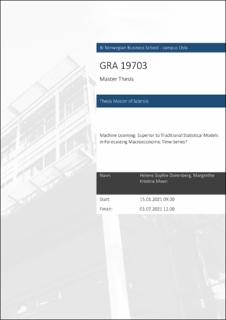Machine Learning: Superior to Traditional Statistical Models in Forecasting Macroeconomic Time-Series?
Master thesis
Permanent lenke
https://hdl.handle.net/11250/2824363Utgivelsesdato
2021Metadata
Vis full innførselSamlinger
- Master of Science [1621]
Sammendrag
This thesis investigates machine learning's potential to forecast the
Norwegian GDP, unemployment rate, and in
ation on monthly or
quarterly, and annual terms. We compare machine learning techniques
such as penalised regressions and random forest to traditional
statistical methods such as the na ve model, autoregressive
and vector autoregressive models. This motivates the following
thesis question, Is value added by machine learning compared to
traditional statistical models in time{series forecasting of macroe-
conomic variables? The results show that the machine learning
models are relatively better than the traditional statistical models
when forecasting except for in
ation. Using many exogenous
variables to explain in
ation is more confusing than value{adding,
therefore, the models depending only on in
ation itself provide the
best forecasts.
Beskrivelse
This thesis investigates machine learning's potential to forecast the
Norwegian GDP, unemployment rate, and in
ation on monthly or
quarterly, and annual terms. We compare machine learning techniques
such as penalised regressions and random forest to traditional
statistical methods such as the na ve model, autoregressive
and vector autoregressive models. This motivates the following
thesis question, Is value added by machine learning compared to
traditional statistical models in time{series forecasting of macroe-
conomic variables? The results show that the machine learning
models are relatively better than the traditional statistical models
when forecasting except for in
ation. Using many exogenous
variables to explain in
ation is more confusing than value{adding,
therefore, the models depending only on in
ation itself provide the
best forecasts.
